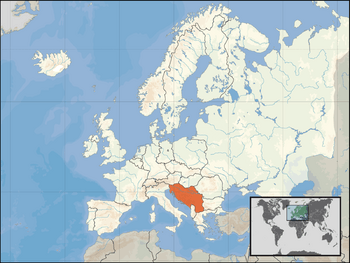Socialist Federal Republic of Yugoslavia facts for kids
Quick facts for kids
Socialist Federal Republic of Yugoslavia
Socijalistička Federativna Republika Jugoslavija
Социјалистичка Федеративна Република Југославија |
|||||||||||||||||||
|---|---|---|---|---|---|---|---|---|---|---|---|---|---|---|---|---|---|---|---|
| 1945–1992 | |||||||||||||||||||
|
Motto: Bratstvo i jedinstvo
"Brotherhood and Unity" |
|||||||||||||||||||
|
Anthem: "Hej, Sloveni'"'
"Hej, Sloveni" |
|||||||||||||||||||
 |
|||||||||||||||||||
| Capital | Belgrade | ||||||||||||||||||
| Common languages | Serbo-Croatian, Slovene, and Macedonian |
||||||||||||||||||
| Government | Various | ||||||||||||||||||
| President | |||||||||||||||||||
|
• 1945 - 1953 (first)
|
Ivan Ribar | ||||||||||||||||||
|
• 1953 - 1980
|
Josip Broz Tito | ||||||||||||||||||
|
• 1991 - 1992 (last)
|
Stjepan Mesić | ||||||||||||||||||
| Prime Minister | |||||||||||||||||||
|
• 1945 - 1953 (first)
|
Josip Broz Tito | ||||||||||||||||||
|
• 1989 - 1991 (last)
|
Ante Marković | ||||||||||||||||||
| Historical era | Cold War | ||||||||||||||||||
|
• Proclamation
|
November 29 1945 | ||||||||||||||||||
| 24 October 1945 | |||||||||||||||||||
|
• Constitutional reform
|
21 February 1974 | ||||||||||||||||||
| 25 June 1991 - 27 April 1992 1992 | |||||||||||||||||||
| Area | |||||||||||||||||||
| July 1989 | 255,804 km2 (98,766 sq mi) | ||||||||||||||||||
| Population | |||||||||||||||||||
|
• July 1989
|
23724919 | ||||||||||||||||||
| Currency | Yugoslav dinar | ||||||||||||||||||
| Time zone | UTC+1 | ||||||||||||||||||
| Calling code | 38 | ||||||||||||||||||
|
|||||||||||||||||||
The Socialist Federal Republic of Yugoslavia (often called SFR Yugoslavia or just Yugoslavia) was a country in Southeast Europe. It existed from 1945, right after World War II, until it broke apart in 1992.
Yugoslavia was a federation, which means it was made of several smaller states joined together. These states were Bosnia and Herzegovina, Croatia, Macedonia, Montenegro, Serbia, and Slovenia. It was a socialist state, which means the government controlled many parts of the economy and society.
After World War II, a temporary government was set up in August 1945. Elections were held in November 1945. Josip Broz Tito and his People's Front party won these elections. Tito became the leader and played a very important role in Yugoslavia's history.
Contents
What Was Yugoslavia?
Yugoslavia was a unique country during the Cold War. It was socialist but tried to stay independent from both the United States and the Soviet Union. This idea was called the Non-Aligned Movement.
The country had different languages, cultures, and religions. The government tried to promote "Brotherhood and Unity" among all its people.
The End of Yugoslavia
Yugoslavia started to break apart in the early 1990s. This happened because of political changes and disagreements between the different republics. Several republics decided to become independent countries.
This led to the Yugoslav Wars, which were a series of conflicts. By 1992, the Socialist Federal Republic of Yugoslavia had formally dissolved. The two remaining states, Serbia and Montenegro, formed a new country called the Federal Republic of Yugoslavia. However, many international leaders did not see this new country as the direct continuation of the old SFR Yugoslavia.
Countries That Were Part of Yugoslavia
Today, the area that was once Yugoslavia is made up of several independent countries. People sometimes call these countries the "former Yugoslavia."
Here are the countries that used to be part of SFR Yugoslavia:
 Slovenia (became independent in 1991)
Slovenia (became independent in 1991) Croatia (became independent in 1991)
Croatia (became independent in 1991) Macedonia (became independent in 1991)
Macedonia (became independent in 1991) Bosnia and Herzegovina (became independent in 1992)
Bosnia and Herzegovina (became independent in 1992) Federal Republic of Yugoslavia (Serbia and Montenegro) (existed from 1992 to 2006)
Federal Republic of Yugoslavia (Serbia and Montenegro) (existed from 1992 to 2006)
 Montenegro (became independent in 2006)
Montenegro (became independent in 2006) Serbia (became independent in 2006)
Serbia (became independent in 2006)
Key Leaders of Yugoslavia
Yugoslavia had several important leaders during its time.
- Josip Broz Tito: He was the most famous leader. He led Yugoslavia from 1953 until he passed away in 1980. He was known for keeping the country united.
- Other leaders served as presidents or prime ministers before and after Tito.
Images for kids
-
Marshal Josip Broz Tito led Yugoslavia from 1944 to 1980.
-
Yugoslav ration stamps for milk, 1950
-
The parliament building of Bosnia and Herzegovina burning amid the Yugoslav wars
-
JAT McDonnell Douglas DC-10-30 at Sydney Airport, 1985, with classic livery
-
The main building of the University of Zagreb and adjacent Faculty of Law
-
The main building of the University of Ljubljana
-
Ivo Andrić, awarded the 1961 Nobel Prize for Literature
See also
 In Spanish: República Federativa Socialista de Yugoslavia para niños
In Spanish: República Federativa Socialista de Yugoslavia para niños
















